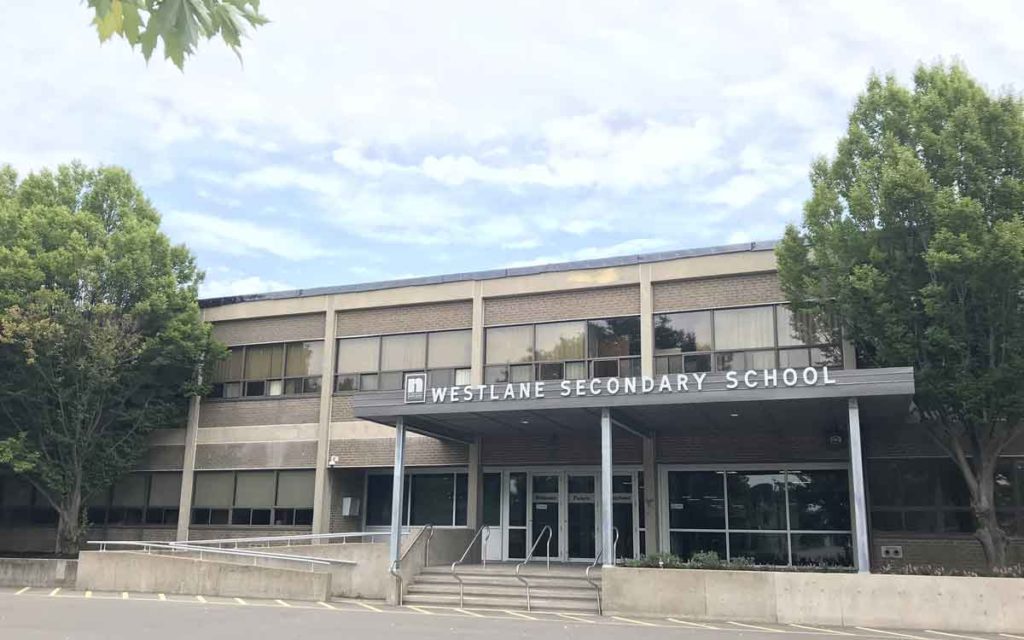
Niagara high schools like Westlane will be part of the adaptive model once school resumes in September.
The Ontario government announced today that it will be back to school for children across Ontario come September and not surprisingly teachers and their unions weren’t happy.
Education minister Stephen Lecce unveiled a plan that has increased health and safety measures, and provides school boards with “unprecedented” resources and flexibility, while accommodating regional differences in trends of key public health indicators.
The plan was developed in consultation with the Chief Medical Officer of Health, the COVID-19 Command Table and pediatric experts.
Elementary schools (Kindergarten to Grade 8) will reopen province-wide, with in-class instruction five days a week. Secondary schools with lower risk will reopen with a normal daily schedule, five days a week, while most secondary schools will start the school year in an adapted model of part-time attendance with class cohorts of up to 15 students alternating between attending in-person and online.
Students from Grade 4-12 and school staff will be required to wear masks.
Niagara high schools will be part of the adaptive model which means students will be organized into two main groups or cohorts. Each cohort has designated days to attend school in class and assigned days to learn online from home within a cycling timeframe.
In a statement on its website the District School Board of Niagara (DSBN) said that the adaptive model is based on decreasing the number of interactions between students and staff, as well as maximizing student learning. The school board said that in-depth details of the secondary adaptive learning plan will be shared with parents shortly.
“With both of these models, students will be back in school learning with their friends and reconnecting with their teachers,” says DSBN Director of Education Warren Hoshizaki. “It also offers some predictability for families for planning. This return to school plan enables all students and staff to transition back to school in as safe an environment as possible.”
The province said that parents will continue to have the option to enroll their children in remote delivery, which respects their fundamental role in making the final determination of whether they feel safe with their children returning to school.
“As a society, we’ve made an important shift in the dialogue about our children and the adverse health impacts of school closures,” says Dr. Ronald Cohn, President and CEO of SickKids. “While we recognize that COVID-19 will be with us for some time, continuing to stay home from school has become untenable for many children, youth and families. Effective, evidence-based strategies can help promote the safety of students, teachers, school staff and families as they return to school.”
Based on medical advice the province said it will be implementing additional public health protocols to keep students and staff safe when they return to school in September. To support the implementation of these protocols, the government is providing over $300 million in “targeted, immediate, and evidence-informed” investments, including:
The funding allocation breakdown is:
$60 million in procurement of medical and cloth masks for students and staff, with direction to boards to ensure that students who cannot afford a mask are provided one;
$30 million for teacher staffing to support supervision, keeping classes small and other safety related measures;
$50 million to hire up to 500 additional school-focused nurses in public health units to provide rapid-response support to schools and boards in facilitating public health and preventative measures, including screening, testing, tracing and mitigation strategies;
Over $23 million to provide testing capacity to help keep schools safe;
$75 million in funding to hire over 900 additional custodians and purchase cleaning supplies for schools;
$40 million to clean school buses, to ensure that students are in a thoroughly cleaned transportation environment;
$10 million for health and safety training for occasional teachers, who have historically not been covered by professional development that is offered to permanent teachers;
$10 million to support special needs students in the classroom; and
$10 million to support student mental health.
“This plan reflects the best medical and scientific advice with a single aim: to keep your child safe,” added Minister Lecce. “While this plan will continue to evolve to respond to the changing threat of COVID-19, we will remain constant and consistent in investing in the resources, staffing, and cleaning supports, and strict health and safety protocols to keep our communities and our classrooms safe.”
“Based on the current data, we are seeing that overall instances of COVID-19 are declining in Ontario. When considering the health of the whole child, and as long as this trend continues, we believe that with the appropriate measures and strategies in place to handle potential outbreaks and prevent spread, schools are expected to be a safe place for Ontario’s students and staff who attend in person,” said Dr. David Williams, Chief Medical Officer of Health. “We will continue to closely monitor the situation to ensure the safety of students and staff and will be prepared to transition to alternative options should circumstances change.”
Reaction from many teachers across the province was instantaneous and not positive. Angry social media posts blanketed twitter and facebook complaining the government did not invest enough money, it’s not safe and teachers will be at risk of infection.
Not surprisingly, teacher unions and their leaders were also quick to criticise the plan while for the most part not offering any alternative solutions. The Elementary Teachers Federation of Ontario tweeted, “While the announcement of new funding is welcome, it’s quite clear that the Ford government isn’t willing to pay the full cost of ensuring the safety of students and educators.” The union does not say what the “full cost” is.
The NDP called the plan “underfunded” and “overcrowded” saying that it puts “the health and academic success of students at risk.”
School boards warn that the plan could change if the Ministry of Education and Niagara Public Health determine it is necessary based on how the COVID-19 pandemic continues to trend.
The first day of school is scheduled for Tuesday, September 8, 2020.

Kevin has spent over two decades as a public relations professional in a variety of sectors including professional sports, the arts, industry and healthcare. After tiring of the daily commute to Toronto he returned to Niagara and launched The Niagara Independent, an online news source published twice weekly.
He is a graduate of Brock University, Niagara College and the Richard Ivey School of Business. He was named one of Niagara’s 40 Under Forty in 2005.
Kevin is most proud of his twin daughters. He is also a triathlete and four-time Ironman finisher.




















